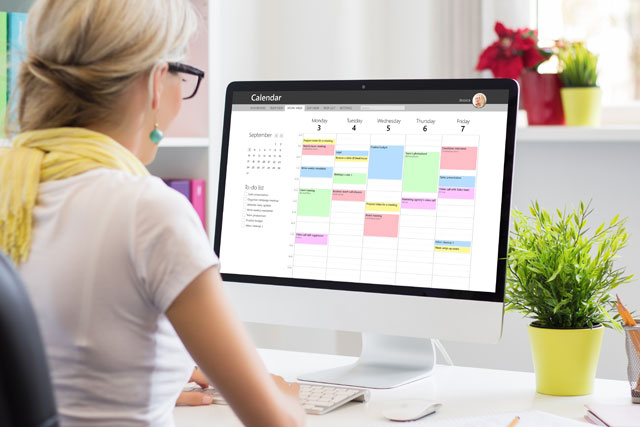We process information in a number of ways, most notably visually and audibly. If your visual aids do not properly match your speech of if they are used in an ineffective manner, this could be a detriment to your speech. Anything that distracts an audience from your message will result in your inability to deliver your message.
Visual aids comprise a wide variety of items, handouts, slides, moving pictures, posters, models, objects, and many others. All of these visual aids are meant to reinforce your main message. Moreover, they become vital when it is necessary to present information that can only be described in a visual format. To use an obvious example, if you are giving a speech to a company's board of directors on the plans for a new building, it would be essential to have a picture or some sort of visual aid to accompany your speech. Yes, it would be possible to give an audible only speech about the new building's plans, but it would be extremely ineffective to do so. There are occasions when a visual aid is a necessary component of your message.
When you are giving a speech, you ideally want the audience to pay complete attention to your voice and message. A visual aid is an invitation for them to pay attention to something else, if even for a moment. Therefore, this visual aid must reinforce your message. The following guidelines will help you decide when visual aids are helpful.
-
Relevancy. Ensure that the visual aids you use are relevant to your speech. This sounds obvious, but many speakers make the mistake of providing "additional information" handouts during a speech. This is one of the worst mistakes a speaker can make. Such handouts would be great to give out after a speech, but certainly not during it.
-
Appropriateness. Likewise, your visual aids should be appropriate to the occasion. You would not typically, for example, use charts and graphs to give an entertaining speech. If the aids are not appropriate, they will distract an audience.
-
Attractiveness. If you are not skilled at using the popular software products typically used to create charts and graphs, and other visual aids, it is best to hire someone who is. An unattractive visual aid will "speak" poorly of you and it will lessen the impact of your message delivery.
-
Visibility. Not everyone in the audience will have 20/20 vision, and not everyone in the back of the room will be able to see small text regardless of their visual ability. Your visual aids must be appropriately sized and legible.
-
Variation. If you are going to use a great many visual aids (and this is only recommended if you feel that it is vital to your message), you should try to incorporate different types of visual aids. Do not use graphs exclusively, for example. This will bore the audience, and it will surely distract them.
Some Rules to Follow when Using Visual Aids
The following are some practices to use and some to avoid when using visual aids.
Good Practices
-
Do use color. Black and whites slides will look boring. Use color even if it is just for a heading for the slide.
-
Make sure the visual aid you are using is visible from at least 8 feet away. If it is legible from approximately that distance, it will be legible to an entire room when it is projected using visual equipment.
-
Consider using clip art. Virtually all computers have some free clip art available. Consider using some on your visual aids, especially if you pick a theme for the art and use a different image on each presentation.
-
Do not keep an image displayed for more than 10 minutes. All visual aids distract some attention from the speaker but this is acceptable since your aids help communicate your message. However, after 10 minutes, the audience will be bored looking at a stale image.
-
Do not use cartoons or other "cute" additions to your presentation unless it is appropriate for your audience.Want to learn more? Take an online course in Motivational and Public Speaking.
-
Do not experiment with different fonts throughout your presentation. Use a single font, but you may use it in different sizes to set off information that is more important. In addition, the use of bold lettering is effective.
-
Do not overuse colors, and make sure that the color is relevant to your message. You would not use a bright blue color, for example, for a slide that is delivering bad news to a company. Similarly, you should not use a wide variety of colors, as this will be distracting to an audience.
Some Logistical Concerns
If you are presenting a speech in a foreign city, the last thing you want to do is transport your own audiovisual equipment. You naturally want the host to provide this equipment for you, and this is considered standard practice. Do not feel it is inappropriate to ask them to do this. When you do ask them, however, the request should be in writing. You want to ensure that you have proof that you have requested this equipment, and be sure to follow up with the host after you have made the request.
Since charts are the most popular type of visual aids used in most speeches, here are some guidelines for their effective use:
-
Do not use all capital letters, ever. Even when you want to emphasize a particular statistic or fact, use color or boldness to accomplish this goal.
-
Is the chart properly labeled? Do not assume that the audience will know little details that you take for granted.
-
Avoid emphasizing certain material with anything other than text; do not use any flashing elements in your aid, boxes, arrows, or any other distracting element.
No course on public speaking would be complete without training on how to control your voice. In this section, we will discuss your voice's quality, articulation, rate, pitch, rhythm, clarity, and inflection. All of these elements are controllable by a public speaker and do determine the overall success of your speech.
Nearly all of us have heard a recording of our own voice at some point in our lives, and we are most often discouraged by what we hear. We think we sound differently, but, in fact, we are hearing our voices as others hear it. Just as practicing the delivery of a speech repeatedly will increase your ability to deliver an excellent speech; you can also practice voice techniques that will improve the overall quality of your voice. However, you should be cautioned that practicing in the wrong way could do more harm than good.
We will discuss pitch and rate in more detail later. Both of these characteristics comprise the overall quality of your voice, and they can both be altered with the proper training and practice.
How well you articulate words will determine the clarity of your speech. During the rehearsal portion of the speech process, it is a good idea to record your speech and play it back at least once so that you can hear how it will sound to an audience. Some things to notice regarding clarity and articulation are the following:
-
Contractions. Some people tend to slur contractions. Take note whether you are clearly pronouncing each element of the contraction. If, for example, you were slurring the contraction "wouldn't," use the two words instead, would not.
-
Reversed words. Some people mispronounce common words that sound alike by reversing the order of some letters. For example, prescription versus perscription. Only the first spelling, and thus, the first pronunciation, is correct.
-
Omitted letters. Good articulation means pronouncing all letters in a word clearly. Do not omit letters. For example, pronounce the "t" in "mists" rather than speaking a word than sounds more like "miss."
Rate of Speech
Your rate of speech is a vital component of the overall quality of your voice. People who are nervous tend to speak more quickly than they normally would, so it is especially important to monitor your rate. When you listen to your rehearsal tape, count the number of words you speak in one minute. You should be speaking at the rate of approximately 150 words per minute. This is not a universal speed. There are times when a speaker may alter this rate slightly, depending on the circumstances. However, a rate of 150 words per minute is a comfortable speed for most informational and motivational speaking.
If you were to use the same pitch and inflection throughout an entire speech, you audience would fall asleep within 10 minutes. Nothing makes a speech more boring than a speaker who uses a monotone pitch and inflection. Pitch describes the level of deepness of your voice, regardless of your gender. A person might have a very high pitch if they are speaking excitedly or a low pitch if they are reading a dramatic reading slowly. Inflection is the varying degree of emphasis that you place on words during speech. For example, if a parent is giving a firm instruction to his or her child, they might say, "You will eat your vegetables." Here, the word will (in italics) will have a different inflection than the rest of the sentence. It is imperative that your speech uses the proper inflection when you wish to emphasize your main point. Let the audience know something is important by using the proper inflection.
Just as it is important to alter the inflection of your voice when you wish to emphasize a thought, it is also important to pause appropriately between thoughts. You should never speak two sentences together back-to-back without a pause if the two sentences each convey an important point or thought. The pace and rhythm of your speech is determined by how fast you are moving from one thought to the next. You want to maintain a comfortable pace, which means always using pauses when appropriate.
Naturally, the volume of your voice is important, and it differs from its pitch. While pitch is used to describe how deep or high your voice is, volume describes how loud your voice is. Volume can easily be controlled and it is one of the most important elements of your voice that you need to control during a speech. If you wish to emphasize something, always remember to use a higher inflection rather than a higher volume. A high volume speaker will be interpreted as screaming to an audience, and that should be avoided whenever possible.






























